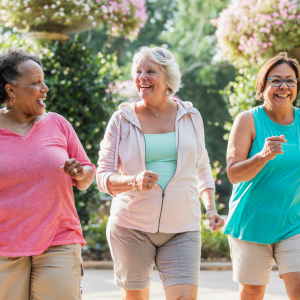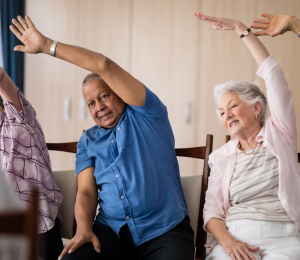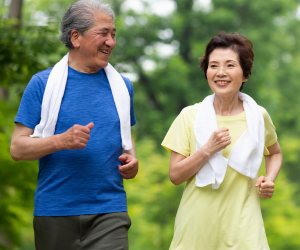Maintain your mobility
Published October 11th, 2023 | Durham Center for Senior Life Blog
By Rebecca Porter RN, MSN, Adult and Gerontology Nurse Practitioner
Mobility can be defined simply as the ability to move yourself, both inside your home and also to locations beyond your home. Mobility can be performed independently, with the help of an assistive device like a cane or a walker, or even with the help of motorized transport like an electric scooter or a car. Being as mobile as possible means people are able to live their lives as fully as they choose. Normal aging leads to the loss of muscle mass, but that doesn’t have to mean loss of mobility.
Physical activity is a great way to maintain and even improve your mobility. The World Health Organization (WHO) defines physical activity as a movement of the body’s skeletal muscles which causes the body to use energy. The WHO recommends that adults age 65 and older complete 150-300 minutes of moderate intensity activity including balance and strength building exercises each week. That translates to about two and half to five hours of activities like walking, riding a bike, or swimming every week. Let’s face it: that can be a lot to accomplish!
The good new is that you will benefit from any physical activity even if you don’t quite reach the WHO’s goal. Doing light physical activity is safe for most people. Please be sure to talk with your primary care provider before you start to increase your activity, to make sure you are staying safe with any health conditions you may have.
The Durham Center for Senior Life has numerous opportunities to engage in physical activities that can promote mobility. Visit DCSL’s weekly class schedule to view all of our offerings.
Benefits of physical activity
Physical activity has many benefits for the body and the mind. It’s no surprise: exercise is good for your heart. One group of Japanese doctors reviewed thirty different research studies and confirmed that the chance of heart disease and stroke were lower for women who participated in physical activity over those who did not. One study showed that simple elbow flexion exercises–also known as bicep curls–lowered participants’ high blood pressure.
Physical activity can also help people stay as functional as possible throughout their lives. Two Canadian researchers reviewed sixty-six different studies and concluded that adults age 65-85 who were more active were also able to live more independently than those who were sedentary.
Visit DCSL’s weekly class schedule to view all of our physical activity offerings.

Exercise snacks

The term “exercise snack” was coined by cardiologist Howard Hartley in 2007. An “exercise snack” is a short burst of activity lasting less than 10 minutes–in some cases, lasting even less than a minute! Fitting in these short exercise periods can help add up to a lot of activity throughout the day. For a lot of people, these short bursts are easier to fit into the day than a longer, more sustained exercise session.
How can you fit in some “exercise snacks?” Some ideas:
● While you are waiting for your coffee to brew in the morning, do ten squats while you hold on to the kitchen counter
● Heating something up in the microwave? March in place or do arm circles until the timer rings.
● During commercial breaks on TV, stand up then sit down again. Repeat as many times as you can until the show starts again. If standing is not an option for you, raise your arms over your head and put them down by your side, or do as many arm circles as you can until the break is over.
Chair exercises
If you are not able to walk or stand up, you can still take action to remain as mobile as possible. The Centers for Disease Control and Prevention (CDC) provide a wide range of chair exercise videos showing how to do activities like chair yoga, chair aerobics, and even latin salsa dancing from your chair. Find more ideas at the CDC website here.
Chair exercises are an option during every class at the the Durham Center for Senior Life. From Bingo-Cize to yoga and tai chi, DCSL has numerous opportunities for movement while in chair. Visit our weekly class schedule to view all of our offerings.

Have fun

If something is fun, you are more likely to do it, right? Find ways to make your mobility more enjoyable. Here are some ideas:
● Counting game: If you are able to walk, try counting how many steps you take with a step counter, also known as a pedometer. Some pedometers clip on to your waistband; some are worn like a watch. If you have a smartphone, it probably has a step counter built in that you can use. See how many steps you can complete in a day.
● Race against the clock: set the timer on your stove or microwave for one minute, and see how many repetitions of one exercise you can complete before the bell rings. Try arm lifts or marching in place.
● Bring a friend: next time you are meeting up with a friend for coffee, how about if you have a short walk together first?
● Join the Durham Center for Senior Life: DCSL offers free activities tailored for older adults, with ample opportunities to engage in physical activity, socialize, learn new things, and join a thriving community.
References
World Health Organization (2022, October 5). Physical Activity. Retrieved August 25, 2023, from https://www.who.int/news-room/fact-sheets/detail/physical-activity
Oguma, Y., & Shinoda-Tagawa, T. (2004). Physical activity decreases cardiovascular disease risk in women: Review and meta-analysis. American Journal of Preventive Medicine, 26(5), 407-418. https://doi.org/10.1016/j.amepre.2004.02.007
Gargallo, P., Casaña, J., Suso-Martí, L., Cuenca-Martínez, F., López-Bueno, R., Andersen, L. L., López-Bueno, L., Cuerda-Del Pino, A., & Calatayud, J. (2022). Minimal Dose of Resistance Exercise Required to Induce Immediate Hypotension Effect in Older Adults with Hypertension: Randomized Cross-Over Controlled Trial. International journal of environmental research and public health, 19(21), 14218. https://doi.org/10.3390/ijerph192114218
Hartley, H. (2007, March 25). An “Exercise Snack” Plan. Newsweek. https://www.newsweek.com/exercise-snack-plan-96095


